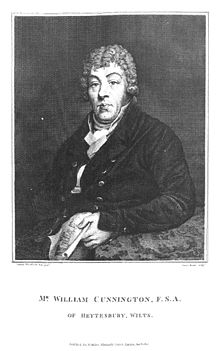William Cunnington
William Cunnington (* 1754 in Heytesbury , Wiltshire , † December 31, 1810 ) was a British archaeologist . He was a draper from Heytesbury, Wiltshire. After his doctor advised him to spend more time in the fresh air, he began digging the prehistoric burial mounds on the Salisbury Plain.
Life
In 1800 he excavated the early Neolithic long mounds of Heytesbury North Field and King Barrow near Boreham near Warminster , and 17 other burial mounds were to follow over the next eight years, including the Bush Barrow . The local MP HP Wyndham and later the antiquarian Richard Colt Hoare of Stourhead funded the excavations. Most of the records of his digs have been lost, but copies of his letters to Wyndham and Hoare have been passed down to his daughters. They not only contained descriptions of the burial mounds and the burials and finds made in them, but also some sketches. Hoare published some of Cunnington's results in his book "Ancient Wiltshire", which appeared in several deliveries between 1810 and 1812.
Cunnington's grandson Robert Henry Cunnington also worked as an archaeologist, as did his great-grandson Ben Cunnington and his wife Maud Cunnington .
interpretation
William Stukeley , who had excavated a long mound in Normanton Down - probably Wilsford South 13 - had interpreted this and similar monuments as the graves of Arch Druids . Wyndham held the Long Mounds for the graves of slain Saxon chiefs and, in rare cases such as Boles Barrow, which contained numerous skeletons, of their retinues who were defeated in battle. He therefore coined the name of the battle hill ("Battle Barrows").
Cunnington, on the other hand, doubted that the great monuments, sometimes paved with stone or built in stone, were erected by the victors just to bury defeated enemies. The mostly small number of skeletons and the numerous animal bones made him doubt their importance as family graves.
William Cunnington identified the Dorset cursus at Cranbourne Chase in 1819 .
Methods
Cunnington had few role models for his research. He examined the hills through long trenches which he first dug through the middle of the hills. In the King-Barrow he used a T-shaped cut with the arms of the T following the axis of the hill. Later he realized that the burial was mostly in the east of the hill and changed the position of his cut accordingly and dug up some of the already examined hills again.
He already used stratigraphic methods and distinguished between primary and secondary burials. As he found, the secondary burials often had metal objects, but the first burials did not.
collection
Cunnington kept his finds in the Moss House on his Heytesbury estate. There the finds were sorted according to location and burial mounds. After Cunnington's death, the collection was sold to Richard Colt Hoare in 1818 for a whopping £ 200. After his death in 1838, Hoare's Stourhead collection was very neglected. In 1878 the collection was loaned to the Museum in Devizes and in 1883 it was bought by the Wiltshire Archaeological and Natural History Society with donations for £ 250.
Digs
- Amesbury 10a, 14
- Boles Barrow (1801)
- Bratton Long Barrow
- Corton
- Durrington 63
- Heytesbury North Field (1800, 1804)
- King Barrow (1800, 1809)
- Knook
- Sherrington Long Barrow
- Tilshead Old Ditch Long Barrow (1802)
- Tilshead Lodge Long Barrow
- White Barrow
- Wilsford 30
- Winterbourne Stoke 53
literature
- Robert H. Cunnington: From Antiquary to Archaeologist. A Biography of William Cunnington 1754-1810. Shire, Aylesbury 1975.
- Bruce Eagles, David Field: William Cunnington and the Long Barrows of the River Wylye. In: Rose Cleal, Joshua Pollard (Eds.): Monuments and material culture. Hobnob Press, Salisbury 2004, ISBN 0-946418-19-5 , pp. 47-69.
- David Field: Earthen Long Barrows. The earliest Monuments in the British Isles. Tempus, Stroud 2006, ISBN 0-7524-4013-6 , pp. 36-37.
- Richard Colt Hoare: The History of ancient Wiltshire. 2 volumes. William Miller London 1810-1812.
Web links
- William Cunnington - Commemorating 200 years of one of Britain's first archaeologists . December 23, 2010
- William Cunnington, portrait
- List of items excavated by William Cunnington in the Wiltshire Heritage Museum
- Short biography at greatarchaeology.com
Individual evidence
- ↑ Ian A. Kinnes, Ian H. Longworth, Ian M. McIntyre, Stuart P. Needham, William A. Oddy: Bush Barrow gold. In: Antiquity. Vol. 62, No. 234, 1988, ISSN 0003-598X , pp. 24-39, doi : 10.1017 / S0003598X00073476 .
| personal data | |
|---|---|
| SURNAME | Cunnington, William |
| BRIEF DESCRIPTION | British archaeologist |
| DATE OF BIRTH | 1754 |
| PLACE OF BIRTH | Heytesbury , Wiltshire |
| DATE OF DEATH | December 31, 1810 |
